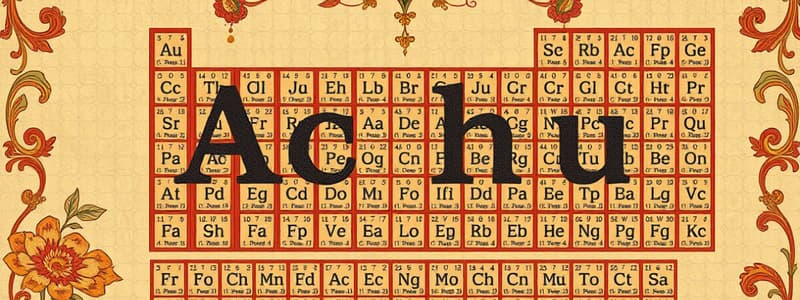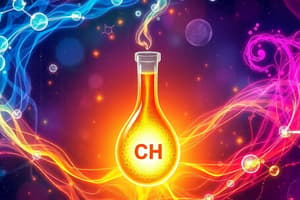Podcast
Questions and Answers
What characterizes alkenes?
What characterizes alkenes?
- They contain at least one triple bond.
- They are saturated hydrocarbons with single bonds.
- They are large molecules essential for life.
- They are unsaturated with at least one double bond. (correct)
What is the primary role of enzymes in biochemical reactions?
What is the primary role of enzymes in biochemical reactions?
- To act as energy sources.
- To provide structural support in cells.
- To speed up chemical reactions. (correct)
- To store genetic information.
Which best describes coordination compounds?
Which best describes coordination compounds?
- Pure elements in their standard states.
- Molecules consisting only of non-metals.
- Compounds with a central metal atom bonded to surrounding molecules or ions. (correct)
- Mixtures of solids that do not form bonds.
Which functional group is typical of alcohols?
Which functional group is typical of alcohols?
What is the purpose of using titration in laboratory techniques?
What is the purpose of using titration in laboratory techniques?
What are the basic units of matter called?
What are the basic units of matter called?
Which type of chemical bond involves the transfer of electrons?
Which type of chemical bond involves the transfer of electrons?
What is the main characteristic of liquid in terms of shape and volume?
What is the main characteristic of liquid in terms of shape and volume?
Which of the following statements is true about acids?
Which of the following statements is true about acids?
What occurs during a decomposition reaction?
What occurs during a decomposition reaction?
How are groups in the periodic table defined?
How are groups in the periodic table defined?
What type of reaction is characterized by the release of heat?
What type of reaction is characterized by the release of heat?
What does 1 mole of a substance refer to?
What does 1 mole of a substance refer to?
Flashcards are hidden until you start studying
Study Notes
Basic Concepts of Chemistry
- Matter: Anything that has mass and occupies space; exists in solid, liquid, and gas states.
- Atoms: Basic unit of matter; composed of protons, neutrons, and electrons.
- Protons: Positively charged, found in nucleus.
- Neutrons: Neutral charge, also in nucleus.
- Electrons: Negatively charged, orbit nucleus.
Periodic Table
- Elements: Pure substances consisting of one type of atom, organized in the periodic table by atomic number.
- Groups/Families: Vertical columns with similar chemical properties.
- Periods: Horizontal rows indicating energy levels of electrons.
Chemical Bonds
- Ionic Bonds: Formed when electrons are transferred from one atom to another, resulting in positive and negative ions.
- Covalent Bonds: Formed when two atoms share electron pairs.
- Metallic Bonds: Involves a 'sea of electrons' shared among metal atoms.
Chemical Reactions
- Reactants and Products: Substances that undergo change (reactants) and the new substances formed (products).
- Types of Reactions:
- Synthesis: Two or more substances combine to form one.
- Decomposition: A single compound breaks down into two or more products.
- Single Replacement: One element replaces another in a compound.
- Double Replacement: Exchange of ions between two compounds.
- Combustion: Reaction with oxygen producing energy and often CO2 and H2O.
States of Matter
- Solid: Definite shape and volume; particles tightly packed.
- Liquid: Definite volume, but takes the shape of its container; particles less tightly packed than solids.
- Gas: No definite shape or volume; particles are far apart and move freely.
Acids and Bases
- Acids: Substances that donate protons (H+) in solution; pH < 7.
- Bases: Substances that accept protons or donate hydroxide ions (OH-) in solution; pH > 7.
- Neutralization: Reaction between an acid and a base to produce water and salt.
Stoichiometry
- Mole Concept: A way to quantify atoms and molecules; 1 mole = 6.022 x 10^23 entities.
- Balancing Equations: Ensuring the number of atoms for each element is the same on both sides of a chemical equation.
Thermochemistry
- Endothermic Reactions: Absorb heat from the surroundings.
- Exothermic Reactions: Release heat to the surroundings.
- Enthalpy (ΔH): Measure of the total energy of a thermodynamic system.
Organic Chemistry
- Hydrocarbons: Compounds composed solely of hydrogen and carbon.
- Alkanes: Saturated hydrocarbons with single bonds.
- Alkenes: Unsaturated with at least one double bond.
- Alkynes: Unsaturated with at least one triple bond.
- Functional Groups: Specific groups of atoms within molecules that determine the characteristics and reactions of those molecules (e.g., -OH in alcohols, -COOH in carboxylic acids).
Inorganic Chemistry
- Coordination Compounds: Molecules consisting of a central metal atom bonded to surrounding molecules or ions.
- Transition Metals: Elements found in Groups 3-12; known for forming colorful compounds and multiple oxidation states.
Biochemistry
- Macromolecules: Large molecules essential for life, including carbohydrates, proteins, lipids, and nucleic acids.
- Enzymes: Biological catalysts that speed up chemical reactions in cells, typically proteins.
Laboratory Techniques
- Titration: Technique to determine concentration of a solution by reacting it with a solution of known concentration.
- Chromatography: Method to separate mixtures based on different affinities of substances.
Safety in Chemistry
- Always wear appropriate personal protective equipment (PPE).
- Be familiar with Material Safety Data Sheets (MSDS) for chemicals used.
- Follow proper waste disposal protocols for hazardous materials.
Basic Concepts of Chemistry
- Matter encompasses anything that possesses mass and occupies space, existing in three states: solid, liquid, and gas.
- Atoms serve as the fundamental units of matter, made up of protons, neutrons, and electrons.
- Protons, which carry a positive charge, are located in the nucleus of an atom.
- Neutrons are neutral particles found within the nucleus, contributing to atomic mass.
- Electrons are negatively charged particles that orbit around the nucleus.
Periodic Table
- Elements are pure substances made up of only one type of atom, arranged in the periodic table by increasing atomic number.
- Groups or families are vertical columns in the periodic table, indicating elements with similar chemical properties.
- Periods refer to horizontal rows representing different energy levels of electrons associated with the elements.
Chemical Bonds
- Ionic bonds arise when electrons are transferred from one atom to another, resulting in charged ions (positive and negative).
- Covalent bonds form when two atoms share pairs of electrons, creating a more stable configuration.
- Metallic bonds occur when a collective pool of electrons is shared among a lattice of metal atoms.
Chemical Reactions
- Chemical reactions involve reactants (substances that undergo change) transforming into products (newly formed substances).
- Five major types of reactions include:
- Synthesis: Combining two or more substances to form a single product.
- Decomposition: Breaking down a single compound into two or more products.
- Single Replacement: One element displaces another element in a compound.
- Double Replacement: Ions are exchanged between two compounds.
- Combustion: A reaction with oxygen that produces energy, often generating CO2 and H2O.
States of Matter
- Solids maintain a definite shape and volume due to tightly packed particles.
- Liquids have a definite volume but adapt to the shape of their container, with particles less tightly packed than in solids.
- Gases lack a definite shape and volume, with particles widely spaced and moving freely.
Acids and Bases
- Acids donate protons (H+) in solution and are characterized by a pH value less than 7.
- Bases accept protons or provide hydroxide ions (OH-) in solution, with a pH greater than 7.
- Neutralization occurs when an acid reacts with a base, resulting in the formation of water and salt.
Stoichiometry
- The mole concept quantifies the number of entities in a substance, with one mole equivalent to 6.022 x 10^23 atoms or molecules.
- Balancing equations is essential to ensure that the number of atoms for each element is equal on both reactant and product sides.
Thermochemistry
- Endothermic reactions absorb heat from their surroundings, while exothermic reactions release heat.
- Enthalpy (ΔH) measures the total energy within a thermodynamic system, reflecting heat changes during chemical reactions.
Organic Chemistry
- Hydrocarbons are molecules consisting only of hydrogen and carbon atoms.
- Alkanes are saturated hydrocarbons characterized by single covalent bonds.
- Alkenes contain at least one carbon-carbon double bond, making them unsaturated.
- Alkynes are unsaturated hydrocarbons with one or more triple bonds.
- Functional groups define the chemical properties and reactive capabilities of organic molecules, such as -OH in alcohols and -COOH in carboxylic acids.
Inorganic Chemistry
- Coordination compounds feature a central metal atom bonded to surrounding molecules or ions, often involving transition metals.
- Transition metals, located in Groups 3-12, are known for forming colorful complexes and exhibiting multiple oxidation states.
Biochemistry
- Macromolecules vital for life, including carbohydrates, proteins, lipids, and nucleic acids, play crucial roles in biological processes.
- Enzymes, typically proteins, act as biological catalysts that accelerate chemical reactions within cells.
Laboratory Techniques
- Titration is employed to determine the concentration of a solution by reacting it with another solution of known concentration.
- Chromatography separates mixture components based on their varying affinities for different substances.
Safety in Chemistry
- Wearing appropriate personal protective equipment (PPE) is essential for laboratory safety.
- Familiarity with Material Safety Data Sheets (MSDS) is crucial for handling chemicals safely.
- Proper disposal protocols for hazardous materials must be followed to ensure safety and compliance.
Studying That Suits You
Use AI to generate personalized quizzes and flashcards to suit your learning preferences.




